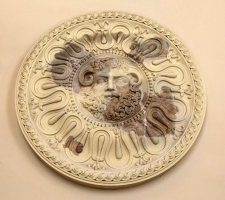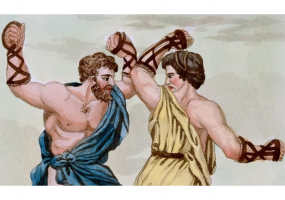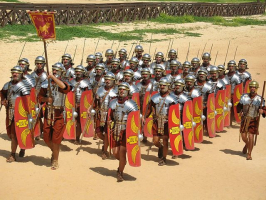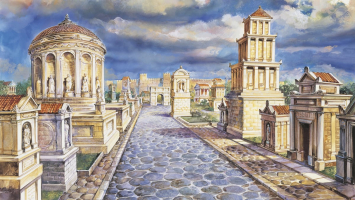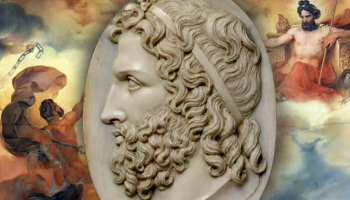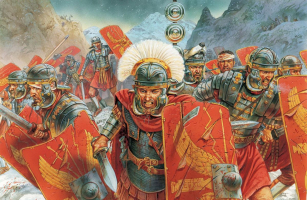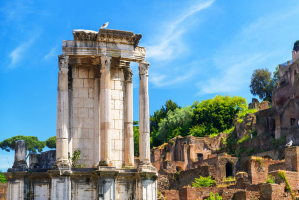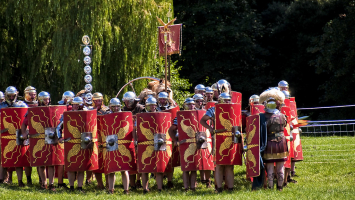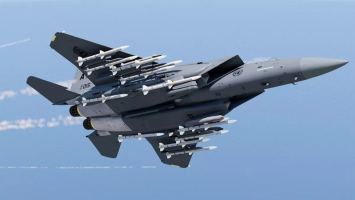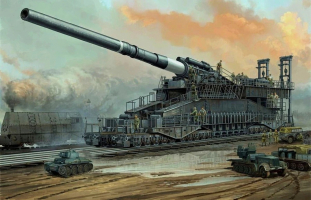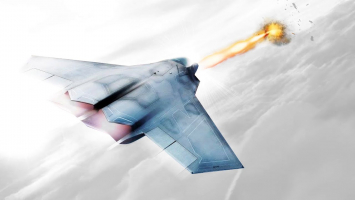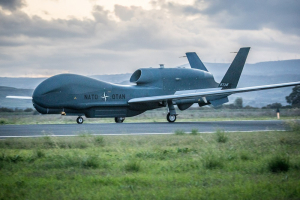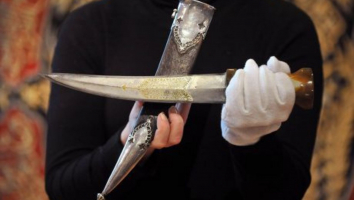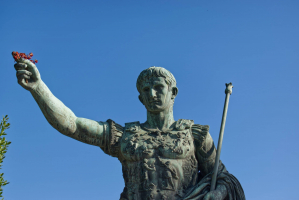Top 10 Ancient Roman Weapons
The weapons used by the Ancient Roman army were crucial in gaining war victories. They used a variety of weaponry, each with its own purpose and role. These ... read more...weapons were extremely effective for the Ancient Romans against their barbarian enemies. Here are the 10 most famous Ancient Roman weapons. Look at the list and discover more information about them.
-
One of the most famous Ancient Roman weapons is the gladius. The Latin word gladius, which means "sword" (of any kind), specifically refers to the sword used by ancient Roman foot soldiers. Early swords used by the Romans, known as xiphe, resembled those used by the Greeks (plural; singular xiphos). But beginning in the third century BC, the Romans adopted a sword known as the gladius hispaniensis, or "Hispanic sword," which was modeled after the weaponry used by the Celtiberians in Hispania during the end of the Punic Wars. From the first century AD to the third century, new varieties and variations of the gladius, such as the "Mainz gladius" and the "Pompeii gladius," were in use until they were replaced by the "spatha" in the third century.
Following Gaius Marius' reforms, a fully armed Roman legionary carried a shield (scutum), one or two javelins (pila), a sword (gladius), frequently a dagger (pugio), and, maybe in the later empire era, darts (plumbatae). Before entering in close battle, for which they drew the gladius, troops would traditionally throw pila to damage the enemy's shields and disrupt their formations. Typically, a soldier would lead with his shield and thrust with his sword.
The three most common types are known as the Mainz gladius, the Fulham gladius, and the Pompeii gladius. An earlier variation, the gladius Hispaniensis, has been discovered through more recent archaeological discoveries. These varieties' subtle differences from one another. The original Hispanic sword featured a slight "wasp-waist" or "leaf-blade" curvature and was in use during the republic. In the early empire, the Mainz variety was used on the frontier. It retained the curve but shortened, broadened, and triangulated the blade. At home, the Pompeii variant was used, which was less effective in battle. The tip was lowered, the blade was lengthened, and the curve was removed. With its long tip and straight edges, the Fulham was a compromise.
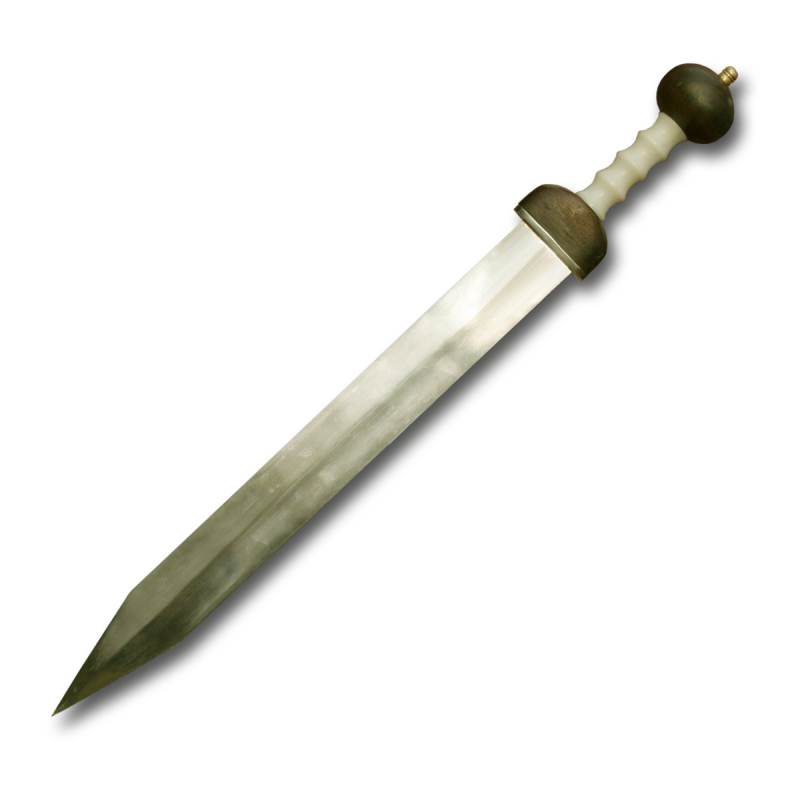
en.wikipedia.org 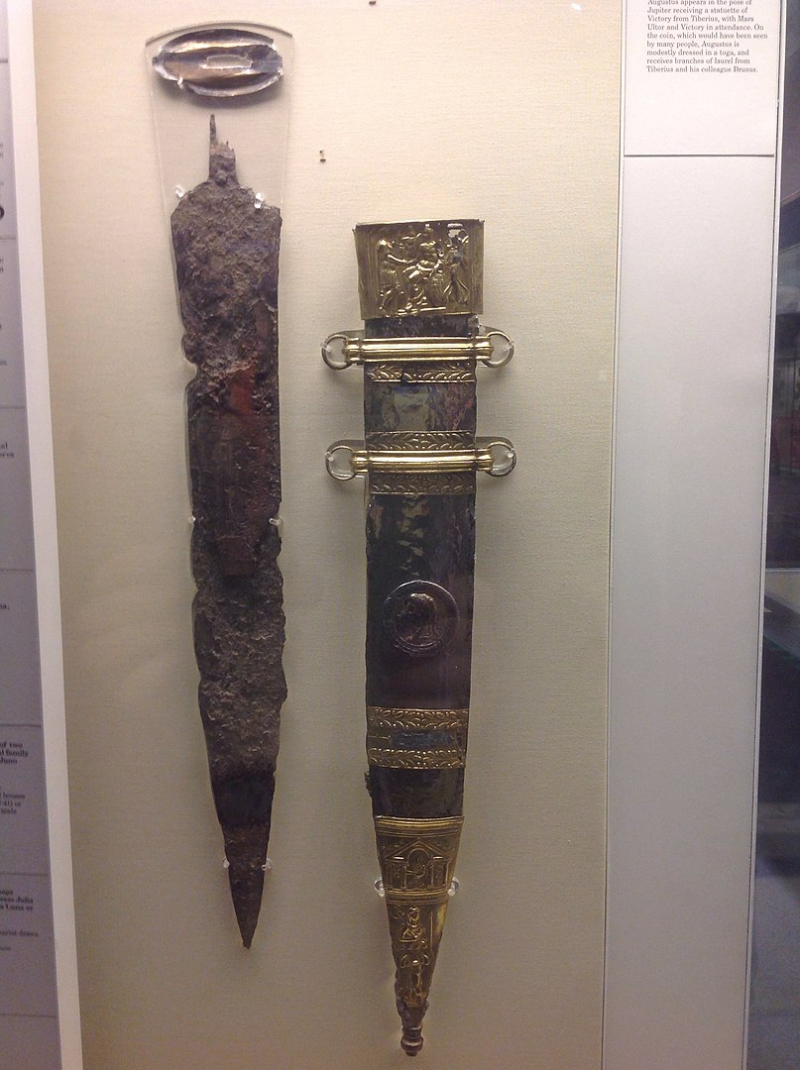
en.wikipedia.org -
Roman troops carried a pugio (a dagger) as a sidearm. The pugio was most likely designed to be a support weapon for the soldier, although its precise function is still unknown. Empire officials began donning elaborate daggers while doing their duties, and others wore concealed daggers for defense in emergency situations. A common assassination and suicide tool was the dagger; for instance, the conspirators who stabbed Julius Caesar used pugiones. The Cantabrians of Iberia wielded daggers, which gave rise to the pugio. The pugio was possibly a stabbing weapon, similar to the gladius, which is the kind of weapon Romans claimed to have liked. The late Roman writer Vegetius claimed that they were the main method of battle adopted by the Romans.
The pugio normally had a big blade by the first century. There were various types of blades. "Leaf-shaped" was one type. Another variety included narrow areas close to the shoulders. It was parallel for roughly half the length of the blade and then drew to a point. Nearly the whole length of each side was made up of midribs, which either protruded from the face or were recessed and delineated by grooves on either side. A grip was riveted through the wide, flat tang and the shoulders of the blade as well as through the tang. The pommel was originally circular, but by the early first century, a round and trapezoidal pommel had taken its place. It frequently has three ornamental rivets on top.
The dagger experienced some modifications during the first fifty years of the first century AD, much like other pieces of legionary gear. When rod tangs were developed, the hilt was merely fastened at the shoulders of the blade and no longer riveted through the tang. Even though the archaeological evidence strongly suggests that the rod tang was less secure and that handles attached in this way could become detached, the existence of two remaining pugiones from various sites that both retain replacement handles, one of which is a recycled sword grip, may prove that this did not significantly alter the pugio's appearance. Some of the blades connected to rod tangs were smaller (less than 4.5 cm (1.75 in) wide), had little to no waisting, or had midribs that were barely there or nonexistent.
The hilt's general shape didn't change much over the period of time. Similar to the earlier era, it was constructed with two layers of horn, wood, or bone sandwiching the tang and each covered in a thin iron plate. The iron plate could either be solid and get thinner at the guard and pommel expansion, which were both roughly trapezoidal in shape, or it could be made of thin metal that was embossed to have this shape. Silver inlay was frequently used to embellish the hilt. Although the grip is relatively small, the existence of an extension in the middle of the grip allows for a very firm hold. The hilt is 10 cm to 13 cm (4 in - 5 in) long overall.
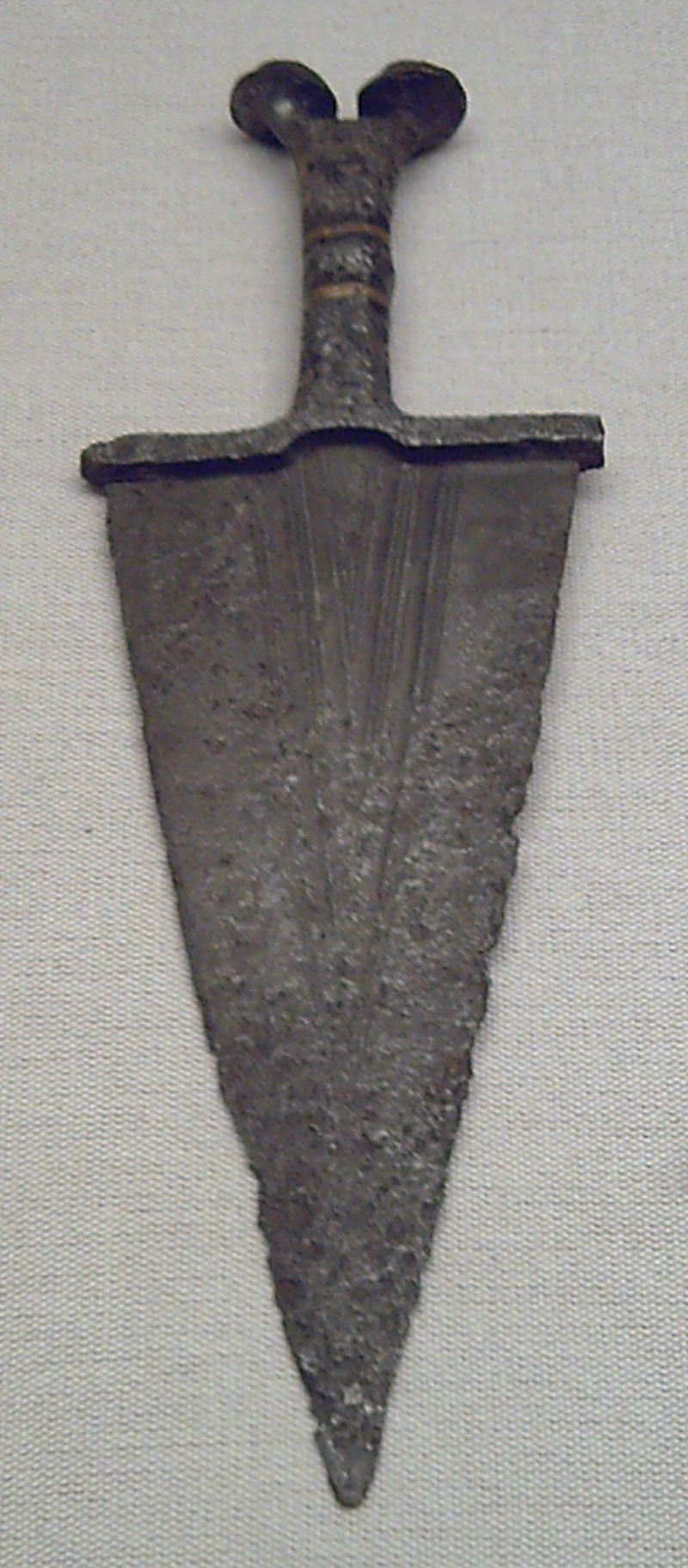
Iberian dagger -en.wikipedia.org 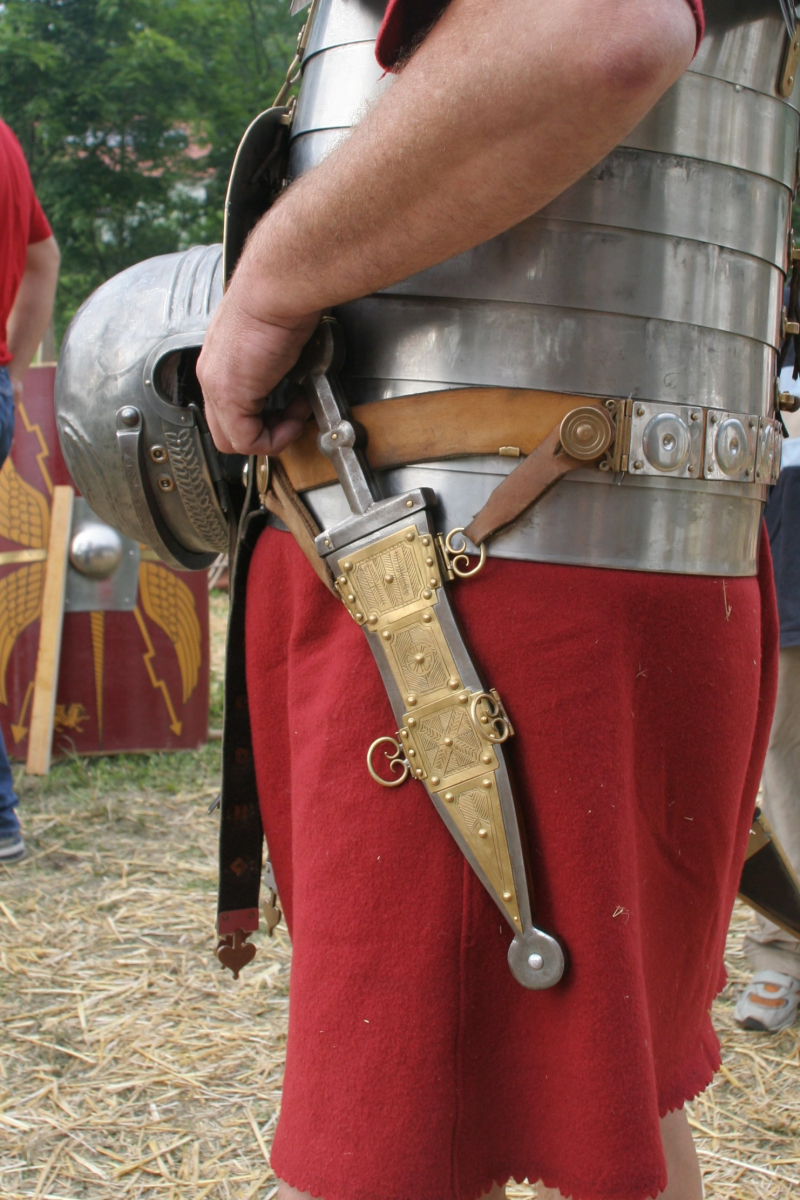
Pugio reconstruction -en.wikipedia.org -
The Roman army often used the pilum (plural pila), a javelin, in ancient times. It had a pyramidal head with an iron shank that was 60 cm long and 7 mm in diameter. Its overall length was often around 2 meters. Either a socket or a flat tang connected the shank to the wooden shaft.
The two models of Pila are heavy and light. According to visual evidence, some versions of the weapon may have been weighted with a lead ball to boost penetrating strength, although no archaeological specimens of that design variant are known. Recent tests have revealed that pila have an effective range of up to 15-20 m and a range of about 33 meters. The tangs of the earliest known instances of the hefty pilum had a figure-eight shape with barbed heads.
Late-republican and early-imperial legions frequently carried two pila, with one being occasionally lighter than the other. Alexander Zhmodikov maintained that the Roman infantry could utilize pila at any point during the battle, contrary to standard tactics that required men to throw one of them (or both, if time permitted) at the enemy right before charging to engage with the gladius.
The pilum throw had the effect of dispersing the opponent formation through attrition and the appearance of breaches in any shield walls serving as protection. The pilum's point is made in such a way that, once lodged inside a shield, it is challenging to extricate; as a result, a shield that had been penetrated by a pilum became difficult to hold and was typically thrown away. Due to the previously indicated openings in the shield wall, the short gladius may then benefit from a close hand-to-hand mêlée.
Pila could also be used in hand-to-hand combat, as documented at the Siege of Alesia and again during Mark Antony's Parthian campaign. Pila could also be used as a thrusting tool and a barrier against cavalry charges. Some pila had small hand-guards to protect the wielder if he planned to use it as a melee weapon, but this does not appear to be common.
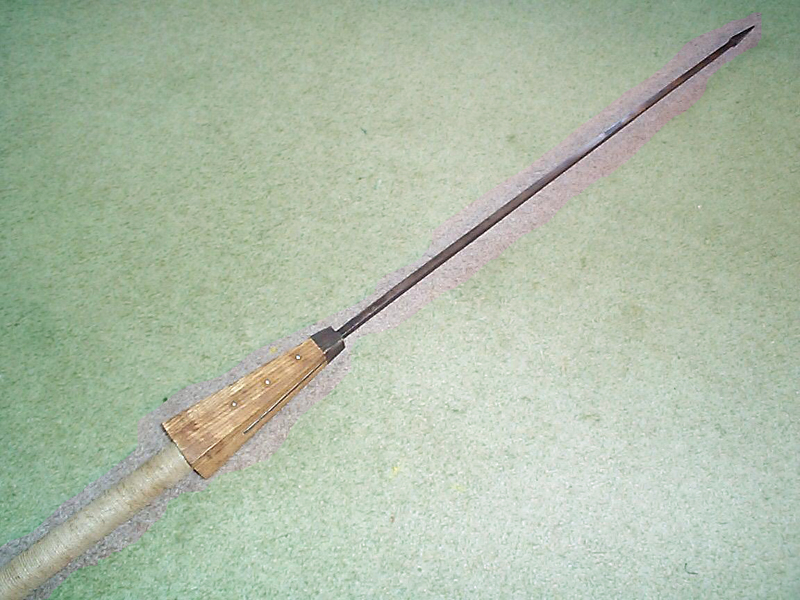
en.wikipedia.org 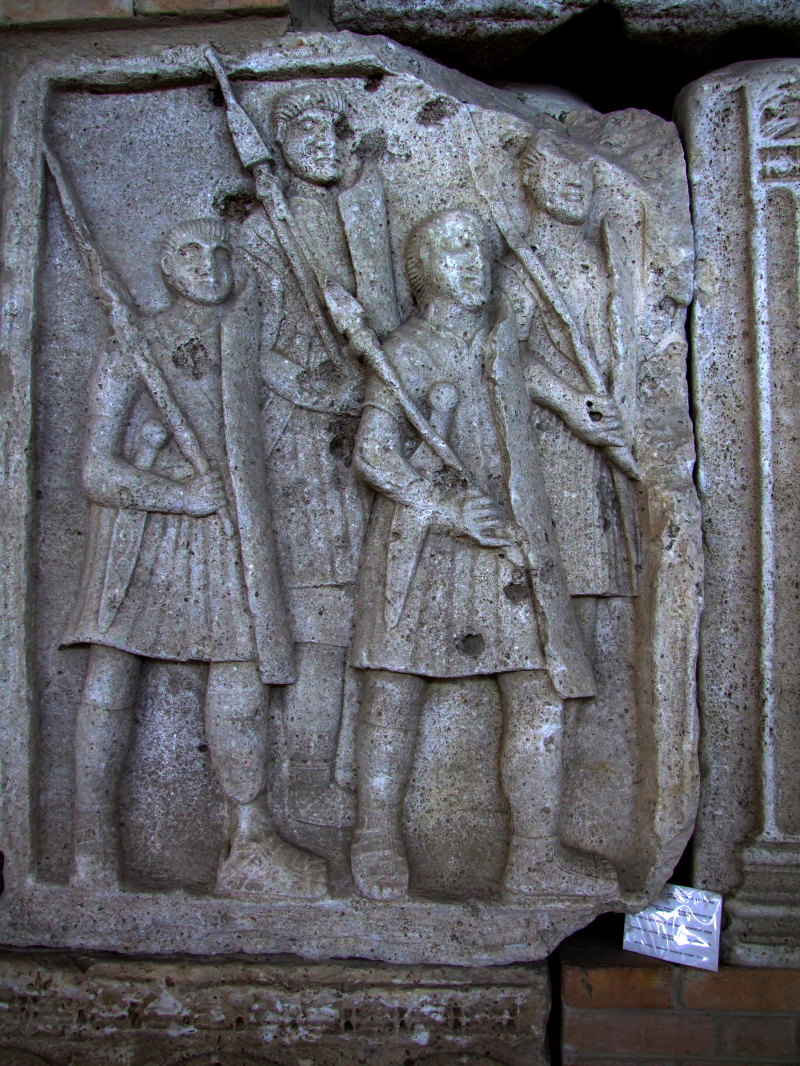
Legionaries carrying pila -en.wikipedia.org -
During the First Punic War, the corvus (Latin for "crow" or "raven") was a Roman naval boarding device used in sea battles against Carthage. This device was described as a bridge with a small parapet on both sides, measuring 1.2 m (4 ft) wide and 10.9 m (36 ft) long. The engine was most likely used in the ship's prow, where a pole and pulley system allowed the bridge to be raised and lowered. When the boarding bridge was lowered, a heavy spike shaped like a bird's beak on the underside of the device was designed to pierce and anchor into an enemy ship's deck. This provided a firm grip between the vessels as well as a path for Roman legionaries (who served as specialized naval infantry known as marinus) to cross onto and capture the enemy ship.
Rome was not a naval power and had little experience in sea combat in the third century BCE. The Roman Republic had never campaigned outside of the Italian Peninsula before the First Punic War began in 264 BCE. The Republic's military strength was in land-based warfare, and its main assets were the Roman soldiers' discipline and courage. The boarding bridge enabled the Romans to use their infantry advantage at sea, assisting them in overcoming the superior naval experience and skills of the Carthaginians. The Romans used boarding tactics to win several battles, including those at Mylae, Sulci, Tyndaris, and Ecnomus.
At the end of the First Punic War, it appears that Rome had abandoned the corvus. As Rome's ship crews gained experience, so did Roman naval tactics; as a result, the relative utility of using the corvus as a weapon may have diminished. After the Battle of Ecnomus, the device is not mentioned in period sources, and it appears that the Battle of the Aegates Islands decided the war in 241 BCE and was won without it. The Roman navy used a different type of device to facilitate boarding attacks by 36 BCE, at the Battle of Naulochus, a harpoon and winch system known as the harpax, or harpago.
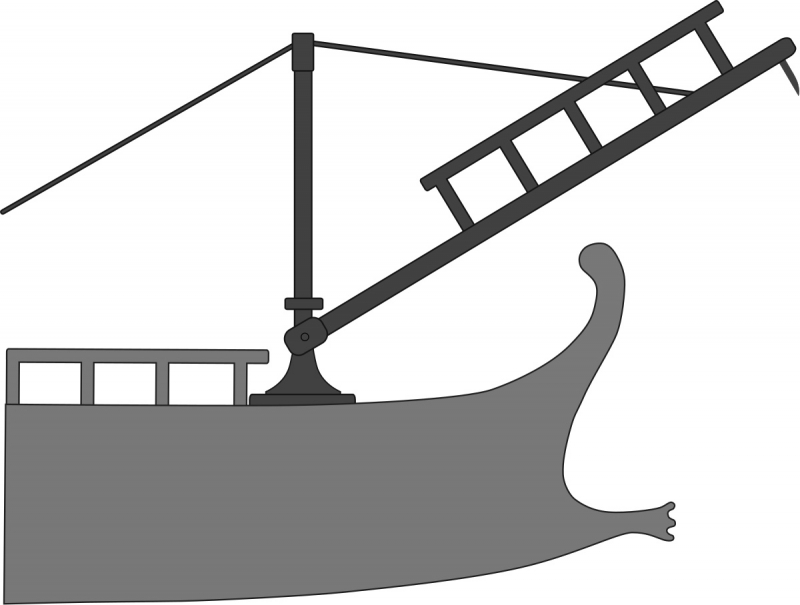
en.wikipedia.org 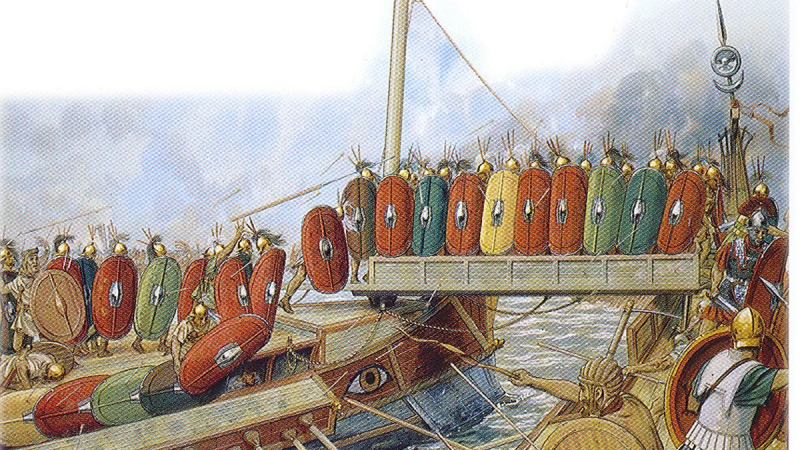
imperiumromanum.pl -
One of the Ancient Roman weapons we want to introduce to you is Plumbata. In Antiquity and the Middle Ages, infantrymen carried lead-weighted darts known as plumbatae or martiobarbuli. The first examples appear to have been carried by the Ancient Greeks around 500 BC, but the late Roman and Eastern Roman armies were the most well-known users.
An image of a plumbatae can be found in the anonymous treatise De Rebus Bellicis. The image depicts a short arrow with a weight attached to the shaft. Although only later copies of the original manuscript exist, this is confirmed by the archaeological remains that have so far been discovered.
Plumbatae is derived from the Latin word plumbum, which means "lead-weighted darts." In this translation, Martiobarbuli is mattiobarbuli in Latin, which is most likely an amalgamation of Martio-barbuli, "small barbs of Mars." Mars, the god of war, was represented by the barb (among other things).
Archaeology provides a more complete picture of martiobarbuli. The reference includes a picture of a Wroxeter item described as a plumbata head and a reconstruction of the entire weapon: a fletched dart with an iron head weighted with lead. The reconstruction appears to be completely congruent with Vegetius' description. Later in the Middle Ages, war darts were also utilized in Europe.
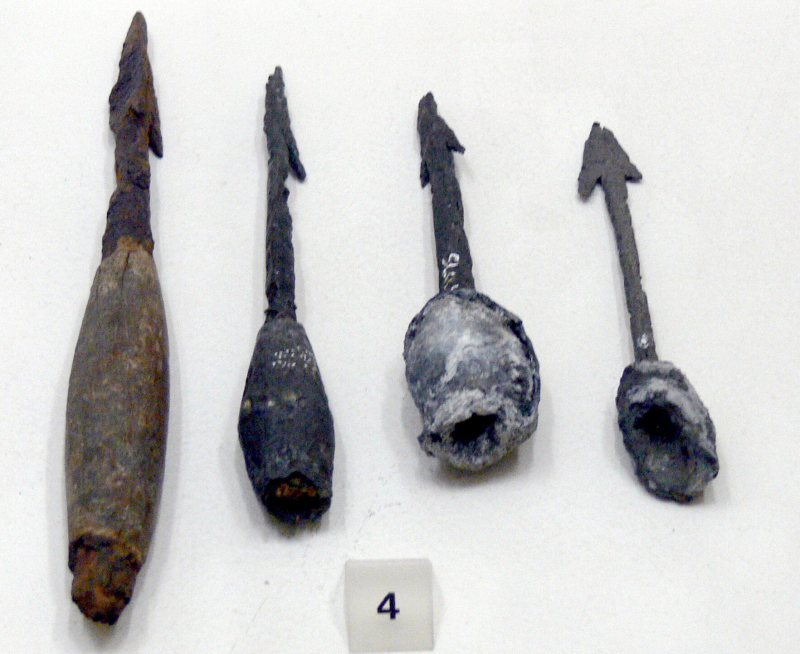
en.wikipedia.org 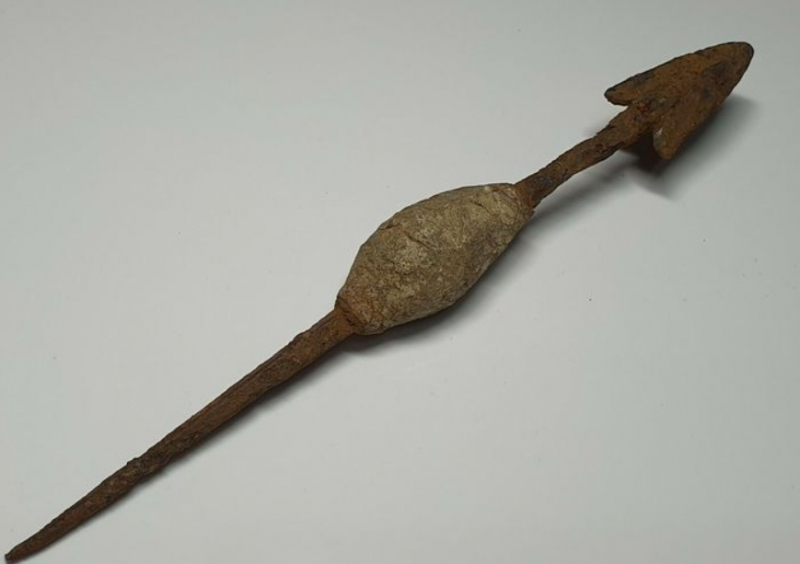
catawiki.com -
The onager was a Roman torsion-powered siege engine. It's usually portrayed as a catapult with a bowl, bucket, or sling at the end of its throwing arm. Ammianus Marcellinus first referenced the onager in 353 CE, describing it as similar to a scorpion. The onager is frequently mistaken with the mangonel, a later "traction trebuchet" that supplanted torsion-powered siege engines in the sixth century CE.
The onager was made out of a massive frame set on the ground to which a vertical frame of strong timber was tightly attached. A cup, bucket, or sling was tied to a vertical spoke that went through a rope bundle fastened to the frame. To fire it, a windlass was used to pull the spoke or arm down against the tension of twisted ropes or other springs, and then suddenly release it. As the sling swung out, one end would release, similar to a staff sling, and the projectile would be launched forward. When the arm was trapped by a padded beam or bed, it could be winched back. According to Ammianus Marcellinus, it took eight men to coil down the arm of a single-armed onager. When it fired, the recoil was so powerful that the onager could not be placed on stone walls because the stones would be displaced. This was validated by a recreated onager that was significantly smaller than the ones described in the sources but still caused significant recoil. Its shot weighed between 3-4kg.
The Roman Empire's onagers were mostly utilized to besiege forts or villages. They were frequently loaded with large stones or pebbles that could be coated in a combustible material and set on fire. In the Middle Ages (about 1200 A.D.), a less powerful variant of the onager was used, which used a stationary bowl rather than a sling, allowing many little projectiles to be thrown rather than a single massive one. This engine was commonly referred to as a mangonel, though the term might refer to a number of siege engines.
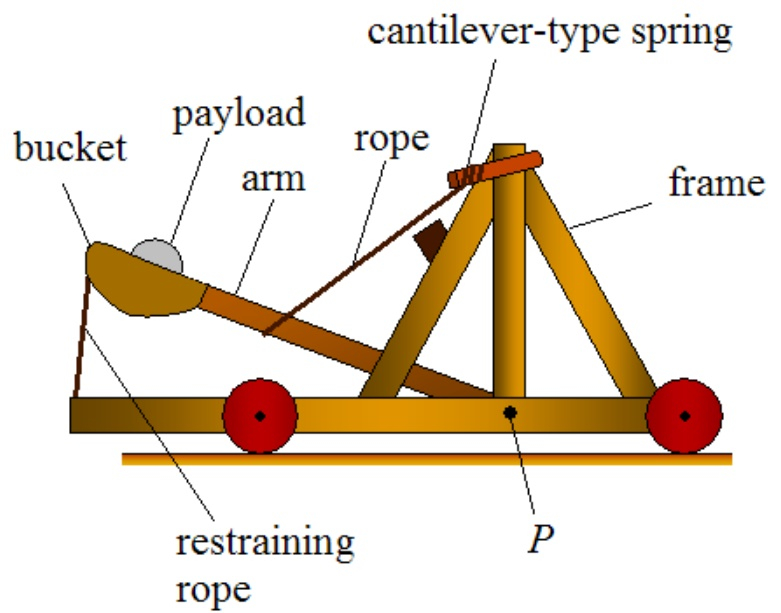
en.wikipedia.org 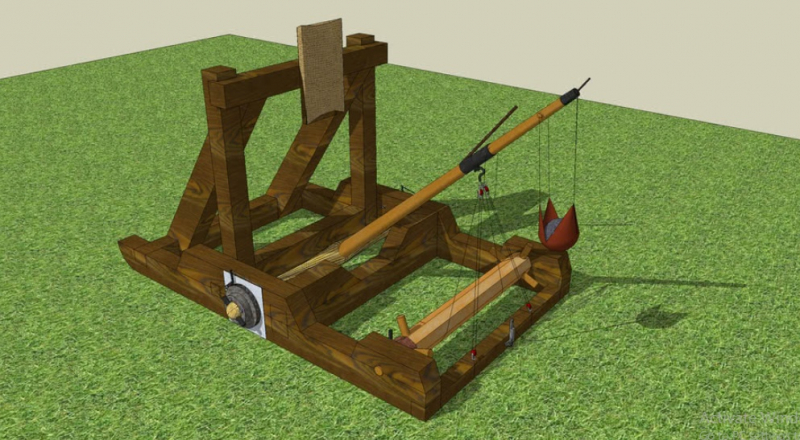
3dwarehouse.sketchup.com -
One of the most famous Ancient Roman weapons is the spatha. The spatha was a type of straight and long sword with a handle length of between 18 and 20 cm (7.1 and 7.9 in) that was used throughout the realm of the Roman Empire from the first to sixth centuries AD. Later swords, from the 7th through 10th century, are unmistakable derivatives and are frequently grouped together under the title spatha.
The Roman spatha was employed in battle and gladiatorial combat. The spatha of literature first appears in the Roman Empire in the first century AD as a weapon used by likely Celtic auxiliaries and subsequently evolved into a standard heavy infantry weapon, relegating the gladius to light infantry use. The spatha appears to have taken the position of the gladius in the front ranks, providing the troops more reach when thrusting. While infantry versions had a long point, cavalry versions had a rounded tip to prevent unintentional stabbing of the cavalryman's own foot or horse.
Celtic mercenaries introduced the spatha to the Roman army during the Second Punic War. The spatha was a weapon used by cavalrymen, whereas the gladius was used by auxiliaries and legionaries. In the second century, the Roman infantry would acquire the spatha. It was a very adaptable sword, evolving from its roots in Gaul to its use in the Roman military. The blade measured 60 to 75 cm (24 to 30 inches) in length.
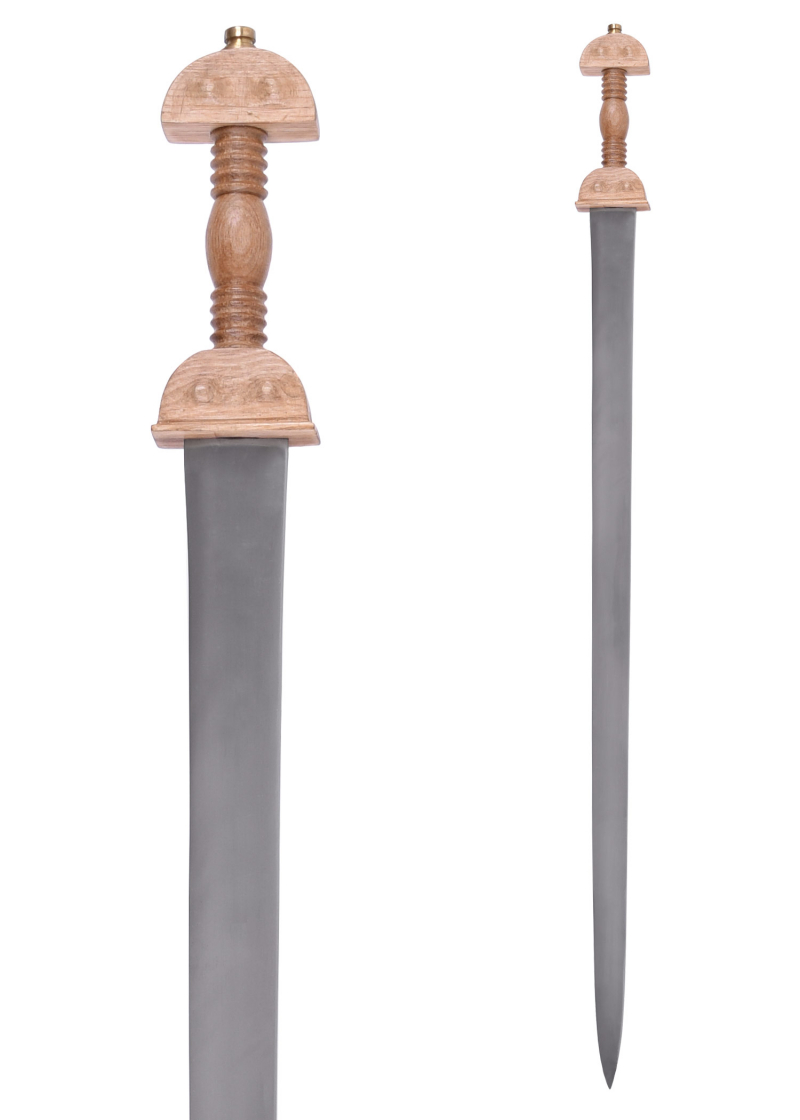
battlemerchant.com 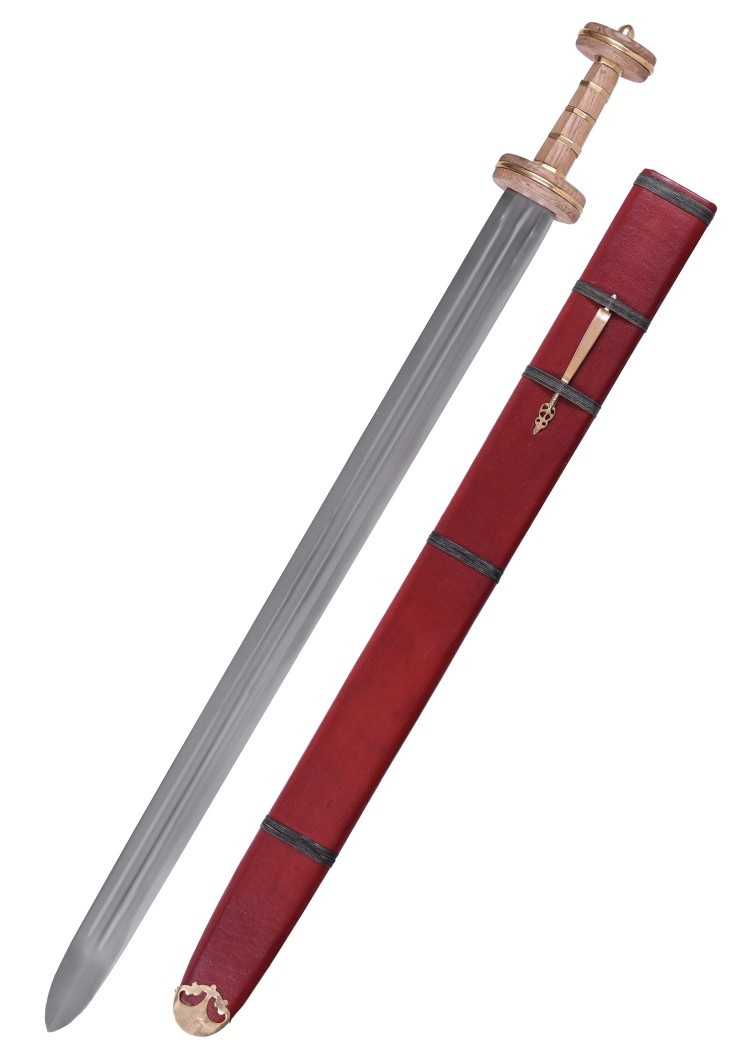
celticwebmerchant.com -
The cheiroballistra was a Roman siege engine from the imperial period. It shot bolts that were smaller than those in other types of ballistae and mainly made of metal. It was designed by Hero of Alexandria and was mostly built of metal (the spring mechanism and the skeins). It was the next significant advancement after the Scorpio. The Scorpio was a sort of Roman torsion siege engine and a field artillery piece. It was recorded in detail by the early-imperial Roman architect and engineer Vitruvius in the first century BC and by the officer and historian Ammianus Marcellinus in the fourth century AD. The scorpio was a small version of the ballista. Its reduced size, metal head, and concave arms provided it with better accuracy and power, allowing it to fire metal bolts with enough force to rip through two opposing soldiers at once under competent hands.
Another first-century CE creation was the cheiroballistra. The weapon was also small enough to be operated by a single shooter and was almost entirely made of metal, including the arms, making it more weather resistant and accurate enough that a sight arch could be inserted between the two copper-encased springs. The weapon's name is a combination of the Greek words for "hand" and "shooter," hinting that portable versions, akin to crossbows, may have existed (a crossbow is a ranged weapon using an elastic launching device consisting of a bow-like assembly called a prod, mounted horizontally on the main frame called a tiller, which is hand-held in a similar fashion to the stock of a long firearm).
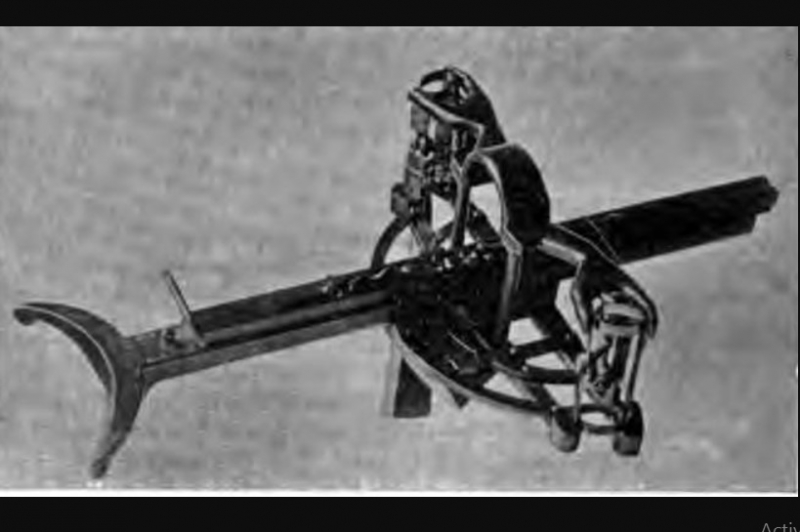
duhoctrungquoc.vn 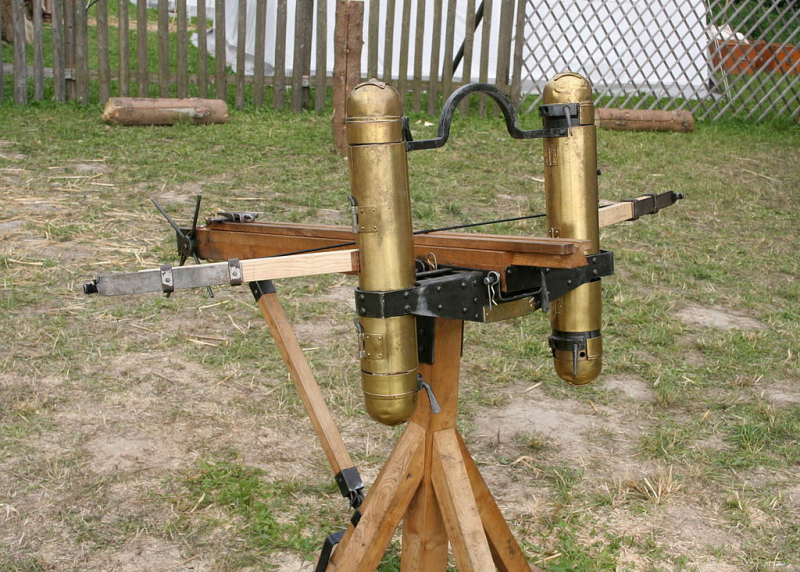
weaponsandwarfare.com -
The lorica segmentata, also known as the lorica lamminata, is a sort of Roman army personal armor made of metal strips fashioned into circular bands and linked to internal leather straps. In popular culture, the lorica segmentata has become synonymous with the Roman legions. The temptation to depict Roman legionaries in this sort of armor often extends to periods in history that are too early or too late.
Legionaries wear the lorica segmentata and carry the curved rectangular shield. Based on this, it has been assumed that lorica segmentata was only employed by legionaries and praetorians. However, some historians believe Trajan's Column is historically wrong due to its erroneous and stylized depiction of Roman armor. The discovery of fragments of the lorica segmentata in regions where auxiliary troops would have been stationed suggests that the lorica segmentata was employed by auxiliary forces. However, it is also plausible that the existence of the lorica segmentata in these places was due to the presence of a limited number of legionaries stationed there. The lorica segmentata does not appear at all on the Adamclisi Tropaeum, and both legionaries and auxilia are represented wearing the lorica squamata.
Some analysts believe that the Adamclisi memorial depicts the incident more accurately. It may have been used infrequently, perhaps just during showpiece wars and parades. According to this opinion, the figures in Trajan's Column are extremely stereotypical in order to clearly distinguish between different classes of troops. It's also debatable whether the lorica segmentata was only utilized in the western world. Every archaeological discovery of such armor has occurred in the western Roman Empire, but never in the east.
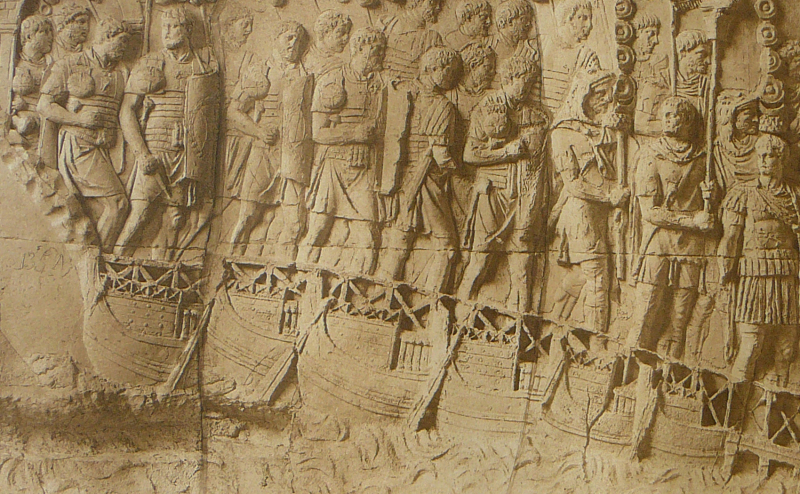
Roman depictions of legionaries wearing lorica segmentata, 2nd century AD -en.wikipedia.org 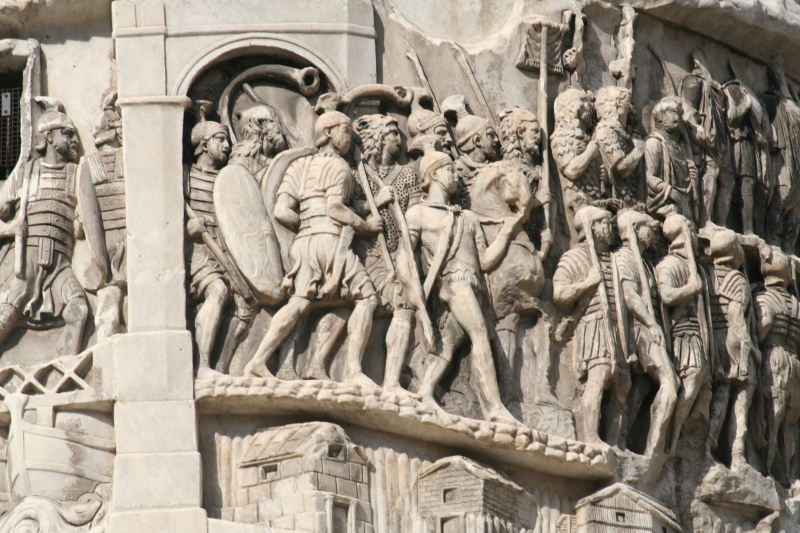
Roman depictions of legionaries wearing lorica segmentata, 2nd century AD -en.wikipedia.org -
Carroballista was a sort of mobile field artillery that was cart-mounted. According to the Roman author Vegetius (Epitoma rei militaris II.25), each legion had 55 carroballistae (one percenturia), who were cheiroballistra arrow/bolt shooters. According to Vegetius, each carroballista was carried by mules and handled by a single contubernium (i.e., eight soldiers commanded by one decanus). The only surviving representations of a carroballista are in the bas-reliefs of Trajan's Column (Scene XL and Scenes LXV/LXVI) and Marcus Aurelius' Column.
The carroballista machine has the same structure as the cheiroballistra or manuballista. It appears that the technical advancements introduced by the Roman army's use of the cheiroballistra around the end of the first century AD enabled the employment of the cart. In fact, the light but strong metal spring frame and the broader area in the frontal half of the machine provided by the arched strut gave the ballista more maneuverability.
According to Trajan's column portrayal (Scene XL), the carroballista was driven by one guy mounted on the cart with the ballista and another man positioned behind the cart, most likely operating some form of the winch handle. The presence of mules in front of the cart implies that the carroballista could readily travel through the battlefield while firing bolts. Scholars do not all agree on this view.
The easy transportation of the ballista is represented in another section of Trajan's column (Scene LXVI), and now we have no arrows or bolts waiting to be released on the ballista, the ballista is empty, and no artilleryman is moving the machine. An artilleryman is hauling the cart near the wheel, implying that the entire mechanism must have been rather hefty.
It is certain that the cart was drawn by two mules or horses, and that it was presumably the size of normal Roman carts, i.e. c. 5 Roman feet (c. 147,85 cm) in breadth (as represented in Trajan's Column, Scenes XL and LXVI), although the cart's overall design is unknown. There are numerous speculations about the cart's structure, and different types of the same equipment appear to have been in use at the same time.
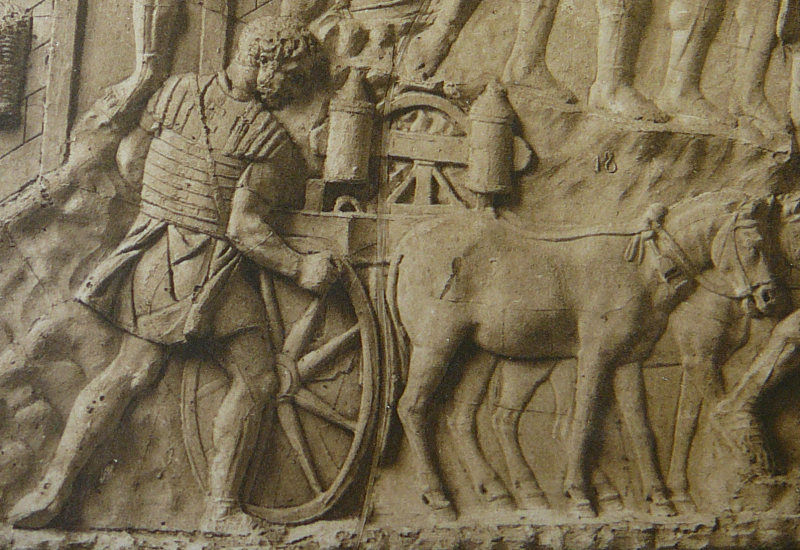
A Roman carroballista from the time of Trajan -en.wikipedia.org 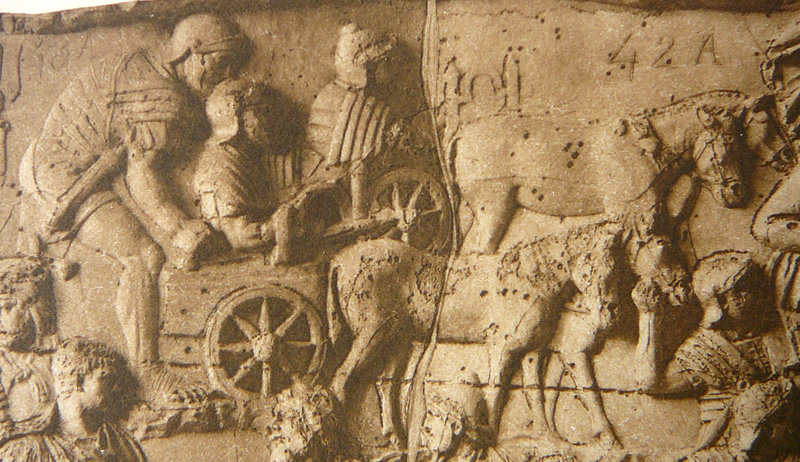
Roman cart-mounted ballista -en.wikipedia.org












